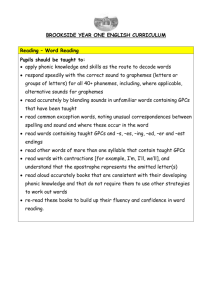Model English Curriculum: Writing Year 2
advertisement
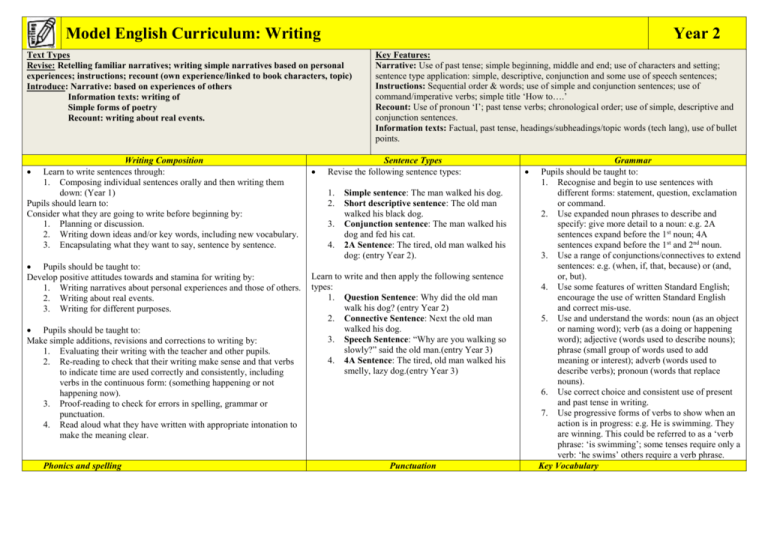
Model English Curriculum: Writing Year 2 Text Types Revise: Retelling familiar narratives; writing simple narratives based on personal experiences; instructions; recount (own experience/linked to book characters, topic) Introduce: Narrative: based on experiences of others Information texts: writing of Simple forms of poetry Recount: writing about real events. Writing Composition Learn to write sentences through: 1. Composing individual sentences orally and then writing them down: (Year 1) Pupils should learn to: Consider what they are going to write before beginning by: 1. Planning or discussion. 2. Writing down ideas and/or key words, including new vocabulary. 3. Encapsulating what they want to say, sentence by sentence. Pupils should be taught to: Develop positive attitudes towards and stamina for writing by: 1. Writing narratives about personal experiences and those of others. 2. Writing about real events. 3. Writing for different purposes. Pupils should be taught to: Make simple additions, revisions and corrections to writing by: 1. Evaluating their writing with the teacher and other pupils. 2. Re-reading to check that their writing make sense and that verbs to indicate time are used correctly and consistently, including verbs in the continuous form: (something happening or not happening now). 3. Proof-reading to check for errors in spelling, grammar or punctuation. 4. Read aloud what they have written with appropriate intonation to make the meaning clear. Phonics and spelling Key Features: Narrative: Use of past tense; simple beginning, middle and end; use of characters and setting; sentence type application: simple, descriptive, conjunction and some use of speech sentences; Instructions: Sequential order & words; use of simple and conjunction sentences; use of command/imperative verbs; simple title ‘How to….’ Recount: Use of pronoun ‘I’; past tense verbs; chronological order; use of simple, descriptive and conjunction sentences. Information texts: Factual, past tense, headings/subheadings/topic words (tech lang), use of bullet points. Sentence Types Revise the following sentence types: 1. 2. 3. 4. Simple sentence: The man walked his dog. Short descriptive sentence: The old man walked his black dog. Conjunction sentence: The man walked his dog and fed his cat. 2A Sentence: The tired, old man walked his dog: (entry Year 2). Learn to write and then apply the following sentence types: 1. Question Sentence: Why did the old man walk his dog? (entry Year 2) 2. Connective Sentence: Next the old man walked his dog. 3. Speech Sentence: “Why are you walking so slowly?” said the old man.(entry Year 3) 4. 4A Sentence: The tired, old man walked his smelly, lazy dog.(entry Year 3) Punctuation Grammar Pupils should be taught to: 1. Recognise and begin to use sentences with different forms: statement, question, exclamation or command. 2. Use expanded noun phrases to describe and specify: give more detail to a noun: e.g. 2A sentences expand before the 1st noun; 4A sentences expand before the 1st and 2nd noun. 3. Use a range of conjunctions/connectives to extend sentences: e.g. (when, if, that, because) or (and, or, but). 4. Use some features of written Standard English; encourage the use of written Standard English and correct mis-use. 5. Use and understand the words: noun (as an object or naming word); verb (as a doing or happening word); adjective (words used to describe nouns); phrase (small group of words used to add meaning or interest); adverb (words used to describe verbs); pronoun (words that replace nouns). 6. Use correct choice and consistent use of present and past tense in writing. 7. Use progressive forms of verbs to show when an action is in progress: e.g. He is swimming. They are winning. This could be referred to as a ‘verb phrase: ‘is swimming’; some tenses require only a verb: ‘he swims’ others require a verb phrase. Key Vocabulary Pupils should continue to apply phonic knowledge and skills as the route to decode words until automatic decoding has become embedded and reading is fluent. To be secure with phase 5 & 6 of the letters and sounds document, especially recognising alternative sounds for graphemes. Read accurately words of two or more syllables that contain the same GPCs as above. Read words containing common suffixes. Read further common exception words, noting unusual correspondence between spelling and sound and where these occur in the word. Read most words quickly and accurately when they have been frequently encountered without overt sounding and blending. Pupils should be shown syllable boundaries and how to read each syllable separately before they combine them to read the word. Pupils should be taught how to read suffixes by building on the root words that they have already learnt. The whole suffix should be taught as well as the letters that make it up. Pupils should be taught to write from memory simple sentences dictated by the teacher that include words/punctuation taught so far. Misspellings of words that pupils have been taught should be corrected. Adding –es to nouns and verbs ending in consonant-letter–y The y is changed to i before –es is added. Segmenting words into phonemes and representing these by graphemes, spelling many correctly. Learning new ways of spelling phonemes for which one or more spellings are already known, and learn some words with each spelling, including a few common homophones. Learning to spell common exception words. Distinguishing between homophones and near-homophones. Add suffixes to spell longer words, e.g. –ment, –ness, –ful and –less Adding –ed, –ing, –er and –est to root words ending in consonantletter–y. Adding the endings –ing, –ed, –er, –est and –y to words ending in vowel-letter–consonant-letter–e. Adding –ing, –ed, –er, –est and –y to words of one syllable ending in a single consonant letter after a single vowel letter. Use of familiar punctuation: capital letters and full stops; Use of exclamation marks, question marks, commas for lists (inc in between adjectives in 2A or 4A sentences); Use of apostrophes for contractions: it is = it’s/did not = didn’t etc The possessive apostrophe (singular nouns) Use of inverted commas to punctuate speech: (entry Year 3). Handwriting Pupils should revise and practise correct letter formation frequently. They should be taught forming individual letters securely with the correct orientation inclusive of entry and exit strokes establishing good handwriting habits from the beginning. Pupils should be taught to write capital letters and digits of the correct size, orientation and relationship to one another and to lower case letters. Use spacing between words that reflects the size of the letters. Pupils should be taught to write with a joined style as soon as they can and to begin joining through teaching all GPCs from phase 3-6 as joined letters within words. Sentence Singular Plural Punctuation Question mark Exclamation mark Apostrophe Comma Noun Conjunction/ connective Speaking & Listening Verb Adjective Adverb Phrase Noun phrase Statement Question Command Tense (past & present). Verb phrase Speak audibly and fluently with an increasing command of Standard English. Use relevant strategies to build their vocabulary. Listen and respond appropriately to adults and their peers. Ask relevant questions to extend their understanding and knowledge. Participate in role-play and discussion.

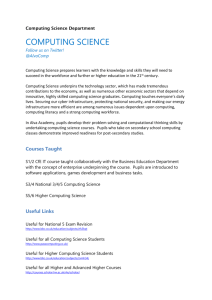


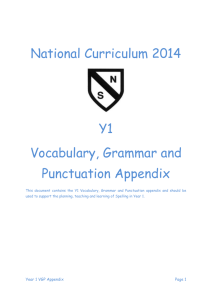
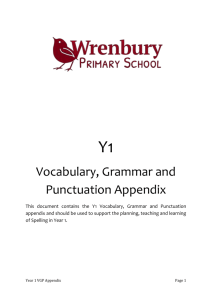
![afl_mat[1]](http://s2.studylib.net/store/data/005387843_1-8371eaaba182de7da429cb4369cd28fc-300x300.png)

